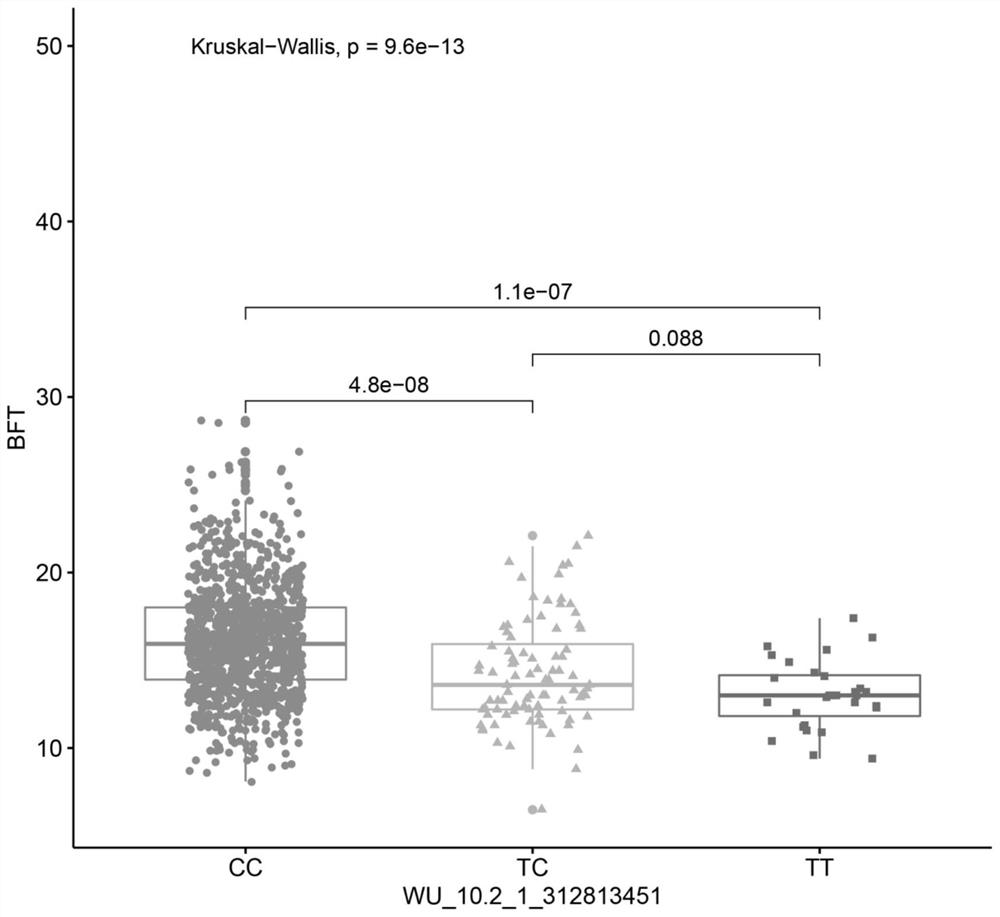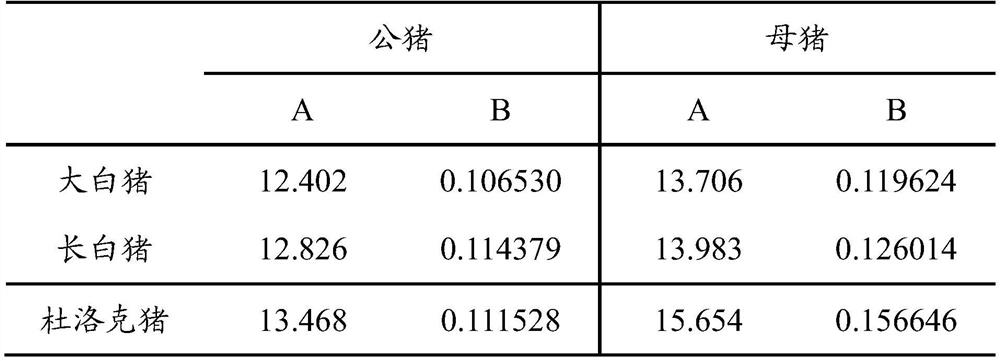SNP marker related to pig backfat thickness and utilization method thereof
A pig backfat thickness and marking technology, applied in the field of pig breeding, can solve problems such as large confidence intervals
- Summary
- Abstract
- Description
- Claims
- Application Information
AI Technical Summary
Problems solved by technology
Method used
Image
Examples
Embodiment approach
[0024] According to a preferred embodiment of the present invention, the SNP marker located at the 312,813,451 bp of chromosome 1 of the Sscrofa10.2 version sequence of the porcine reference genome has a C / T polymorphism.
[0025] Among them, the two alleles of this SNP site are C and T, the gene frequency of C is 0.9773, the gene frequency of T is 0.0627, and C is the dominant allele.
[0026] In a further preferred embodiment, the pigs whose genotype is TT at the SNP site at No. 312,813,451 bp of chromosome 1 of the Sscrofa10.2 version sequence of the pig reference genome have more genetic characteristics than pigs whose genotypes are TC and CC. Low backfat thickness.
[0027] In the present invention, there are three genotypes corresponding to the SNP site at No. 1 chromosome 312,813,451bp of the pig reference genome Sscrofa10.2 version sequence, respectively TT, TC and CC, and the TT genotype is that the site is Homozygous for base T, TC genotype is heterozygous for this ...
Embodiment 1
[0069] Example 1 Obtaining of SNP sites
[0070] 1. Test group
[0071] The pig population used in this example is 1148 pigs from Hebei Meishen original sow farm, including 588 Large White pigs, 371 Landrace pigs and 189 Duroc pigs.
[0072] 2. Determination and correction of backfat thickness
[0073] When the pig’s individual weight is in the range of 85-105kg, the backfat thickness of the living body is measured, and the backfat thickness of the penultimate 3rd to 4th intercostal space is measured by B-ultrasound scanning, in millimeters; finally, the pig’s body weight of 100kg is calculated according to the following correction formula Live backfat thickness:
[0074] The relationship between the corrected backfat thickness and the measured backfat thickness is:
[0075] Corrected backfat thickness = measured backfat thickness × CF (where: CF = A÷{A+[B×(measured body weight-100)]});
[0076] Wherein, sow CF value=(measured body weight / measured age)×1.714615.
[0077...
Embodiment 2
[0100] Example 2 Correlation results between different genotypes of SNP loci and backfat thickness
[0101] Get the genomic DNA of the pig population in Example 1, adopt the Neogen_POR80K of Neogen Company to detect the genotype of each individual, extract the sequence of the polymorphic site by R language, and count the genotype frequency and gene frequency distribution of the SNP site, The results are shown in Table 2:
[0102] Table 2
[0103]
[0104] It can be seen from Table 2 that C is the dominant allele, and CC genotype is the dominant genotype of the test population.
[0105] The Kruskal-Wallis method was used to test the significance of differences between the genotype data and phenotype data using Rstudio software, and a P-value<0.05 indicated a significant difference. The results of the correlation analysis are shown in Table 3:
[0106] table 3
[0107]
[0108] It can be seen from Table 3 that there are significant differences in the corrected backfat ...
PUM
 Login to View More
Login to View More Abstract
Description
Claims
Application Information
 Login to View More
Login to View More - R&D
- Intellectual Property
- Life Sciences
- Materials
- Tech Scout
- Unparalleled Data Quality
- Higher Quality Content
- 60% Fewer Hallucinations
Browse by: Latest US Patents, China's latest patents, Technical Efficacy Thesaurus, Application Domain, Technology Topic, Popular Technical Reports.
© 2025 PatSnap. All rights reserved.Legal|Privacy policy|Modern Slavery Act Transparency Statement|Sitemap|About US| Contact US: help@patsnap.com



